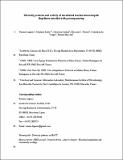Por favor, use este identificador para citar o enlazar a este item:
http://hdl.handle.net/10261/71764COMPARTIR / EXPORTAR:
 SHARE SHARE
 CORE
BASE CORE
BASE
|
|
| Visualizar otros formatos: MARC | Dublin Core | RDF | ORE | MODS | METS | DIDL | DATACITE | |

| Título: | Diversity patterns and activity of uncultured marine heterotrophic flagellates unveiled with pyrosequencing |
Autor: | Logares, Ramiro CSIC ORCID ; Audic, Stephane; Santini, Sebastien; Pernice, Massimo CSIC ORCID ; Vargas, Colomban de; Massana, Ramon CSIC ORCID | Palabras clave: | Diversity Heterotrophic flagellates MAST Pyrosequencing Stramenopiles |
Fecha de publicación: | abr-2012 | Editor: | Nature Publishing Group | Citación: | ISME Journal - International Society for Microbial Ecology 6: 1823-1833 (2012) | Resumen: | Flagellated heterotrophic microeukaryotes have key roles for the functioning of marine ecosystems as they channel large amounts of organic carbon to the upper trophic levels and control the population sizes of bacteria and archaea. Still, we know very little on the diversity patterns of most groups constituting this evolutionary heterogeneous assemblage. Here, we investigate 11 groups of uncultured flagellates known as MArine STramenopiles (MASTs). MASTs are ecologically very important and branch at the base of stramenopiles. We explored the diversity patterns of MASTs using pyrosequencing (18S rDNA) in coastal European waters. We found that MAST groups range from highly to lowly diversified. Pyrosequencing (hereafter ‘454’) allowed us to approach to the limits of taxonomic diversity for all MAST groups, which varied in one order of magnitude (tens to hundreds) in terms of operational taxonomic units (98% similarity). We did not evidence large differences in activity, as indicated by ratios of DNA:RNA-reads. Most groups were strictly planktonic, although we found some groups that were active in sediments and even in anoxic waters. The proportion of reads per size fraction indicated that most groups were composed of very small cells (~2–5 μm). In addition, phylogenetically different assemblages appeared to be present in different size fractions, depths and geographic zones. Thus, MAST diversity seems to be highly partitioned in spatial scales. Altogether, our results shed light on these ecologically very important but poorly known groups of uncultured marine flagellates | Descripción: | 11 pages, 7 figures, 2 tables | Versión del editor: | https://doi.org/10.1038/ismej.2012.36 | URI: | http://hdl.handle.net/10261/71764 | DOI: | 10.1038/ismej.2012.36 | ISSN: | 1751-7362 | E-ISSN: | 1751-7370 |
| Aparece en las colecciones: | (ICM) Artículos |
Ficheros en este ítem:
| Fichero | Descripción | Tamaño | Formato | |
|---|---|---|---|---|
| Logares_et_al_2012_postprint.pdf | 375,94 kB | Adobe PDF |  Visualizar/Abrir |
CORE Recommender
PubMed Central
Citations
39
checked on 15-abr-2024
SCOPUSTM
Citations
103
checked on 15-abr-2024
WEB OF SCIENCETM
Citations
99
checked on 29-feb-2024
Page view(s)
395
checked on 18-abr-2024
Download(s)
194
checked on 18-abr-2024
Google ScholarTM
Check
Altmetric
Altmetric
Artículos relacionados:
NOTA: Los ítems de Digital.CSIC están protegidos por copyright, con todos los derechos reservados, a menos que se indique lo contrario.
